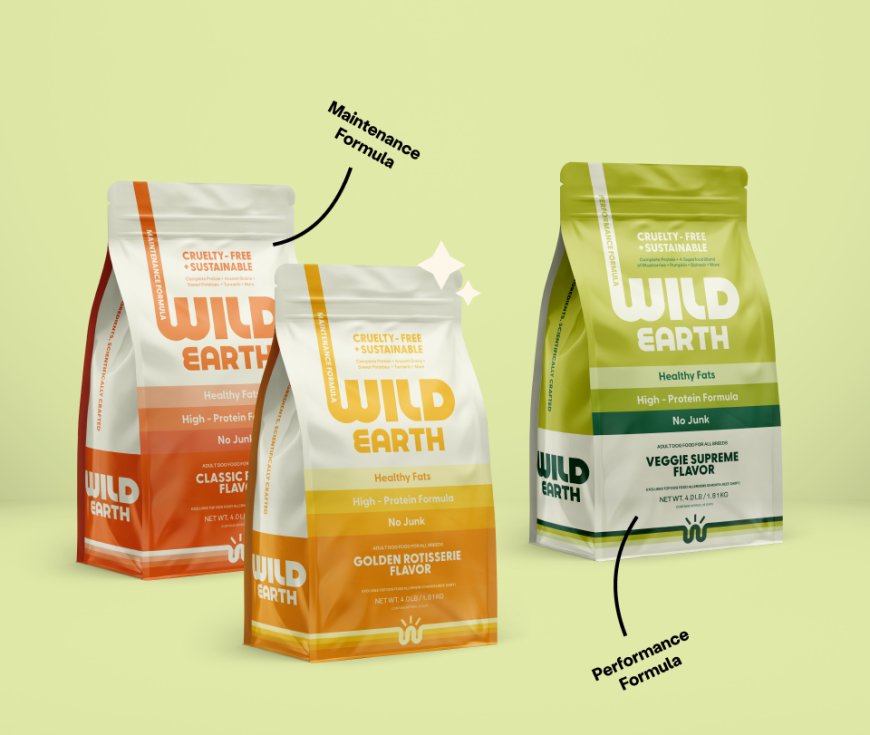How Much Should You Feed Your Pet? A Simple Guide
At Wild Earth, we understand that every pet is unique, and we are committed to providing tailored nutrition that meets your furry friend's specific needs.
Feeding your pet the right amount of Pet Food is crucial for their health and well-being. Not only does it affect their weight, but it also impacts their energy levels, mood, and overall health. In this guide, we will explore the factors that determine how much you should feed your pet and provide you with a simple framework to help you make the best decisions. At Wild Earth, we understand that every pet is unique, and we are committed to providing tailored nutrition that meets your furry friend's specific needs.
Understanding Your Pet's Nutritional Needs
Before deciding how much to feed your pet, it is essential to understand their nutritional needs. Factors such as age, breed, size, and activity level all play significant roles in determining the appropriate portion sizes.
What Are the Key Factors in Determining Portion Sizes?
When it comes to determining how much food your pet requires, consider the following key factors:
-
Age: Puppies and kittens have different nutritional needs than adult and senior pets. They require higher levels of certain nutrients to support their growth and development. For example, Wild Earth offers specially formulated puppy food that ensures young pets receive the right balance of protein, fats, and carbohydrates for their active lifestyles.
-
Weight and Body Condition: Maintaining a healthy weight is crucial for your pet's overall health. If your pet is overweight, they may require fewer calories to help them reach a healthy weight. Conversely, underweight pets might need more calories. Using a body condition score (BCS) can help you assess whether your pet is at a healthy weight. Wild Earth provides nutritional information that can help pet owners adjust their feeding based on their pet's specific needs.
-
Activity Level: An active pet will require more calories than a less active one. For instance, a working dog may need a high-performance diet to sustain their energy levels throughout the day. Wild Earth offers high-protein options that cater to high-energy breeds, ensuring they receive the right fuel to stay active and healthy.
-
Health Conditions: Some pets may have health issues that affect their nutritional needs. For example, pets with certain medical conditions may require specialized diets that restrict certain ingredients. Wild Earth takes pride in offering plant-based options that can be beneficial for pets with dietary sensitivities or allergies.
Understanding these factors is the first step in determining how much you should feed your pet. Wild Earth emphasizes the importance of individualized nutrition, ensuring that every pet receives the best care tailored to their unique circumstances.
How to Read Feeding Guidelines
Feeding guidelines can often be found on the packaging of Pet superfood. However, these guidelines are typically based on average requirements and may not be suitable for every pet. Understanding how to interpret these guidelines is essential for determining the right amount to feed your pet.
What Should You Look for in Feeding Guidelines?
When examining the feeding guidelines, consider the following points:
-
Weight Range: Most feeding charts will provide a recommended amount based on your pet’s weight. Ensure that you select the right weight range for your pet. For example, if your pet weighs 20 pounds, follow the recommendations for that specific weight category.
-
Caloric Needs: Some pet food packaging will list the number of calories per serving. You can use this information to calculate how many calories your pet needs daily. For instance, if your dog requires 600 calories a day and each cup of their food contains 300 calories, you would feed them two cups per day.
-
Active vs. Inactive Pets: The feeding guidelines might also differentiate between active and inactive pets. If your pet is more sedentary, you may need to adjust the portion sizes accordingly. At Wild Earth, we provide detailed feeding guidelines to help pet owners make informed choices.
-
Life Stage Considerations: Make sure to adjust the feeding amounts based on your pet’s life stage. Puppies and kittens require more food than adult pets due to their rapid growth. Wild Earth offers age-appropriate formulas that cater to these changing needs, ensuring that your pet receives the nutrition they require at every stage of life.
While feeding guidelines provide a helpful starting point, it is essential to monitor your pet’s condition and adjust their food intake as necessary. Wild Earth encourages pet owners to consult with their veterinarians to develop a personalized feeding plan that meets their pet’s specific needs.
How Often Should You Feed Your Pet?
The frequency of feeding your pet can significantly influence their digestion, energy levels, and overall health. While some pets thrive on one meal per day, others may benefit from multiple smaller meals.
What Are the Recommended Feeding Frequencies?
The recommended feeding frequency can vary based on your pet’s age and health needs:
-
Puppies and Kittens: Young animals typically require more frequent feeding. For example, puppies may need to be fed three to four times a day to support their rapid growth and high energy levels. Wild Earth offers puppy formulas rich in nutrients to help them grow strong and healthy.
-
Adult Dogs and Cats: Most adult pets do well with two meals per day. This routine helps maintain their energy levels and prevents overeating. When feeding adult pets, it’s essential to divide their total daily caloric intake into two meals for better digestion and absorption.
-
Senior Pets: Older pets may benefit from more frequent, smaller meals to help with digestion. They often have slower metabolisms and may require fewer calories. Additionally, senior pets may have specific dietary needs, and Wild Earth offers formulations designed to cater to their unique nutritional requirements.
-
Health Considerations: Pets with certain medical conditions may require a specific feeding schedule. For instance, pets with diabetes might need more regular meal times to manage their blood sugar levels. Wild Earth recognizes these needs and guides to help pet owners choose the right products for their pets.
Feeding frequency is just one aspect of your pet’s diet. Wild Earth emphasizes the importance of listening to your pet's needs and observing their behavior and energy levels. Adjustments may be necessary to find the right balance that works for your furry friend.
How to Adjust Portion Sizes Based on Weight and Activity Level
Once you have established a baseline feeding amount for your pet, it’s crucial to monitor their weight and adjust the portion sizes accordingly. Regularly weighing your pet and assessing their body condition can help you maintain their ideal weight.
How Can You Effectively Adjust Portion Sizes?
Here are some steps to consider when adjusting your pet's portion sizes:
-
Regular Weigh-Ins: Weigh your pet every few weeks to track any changes in their weight. If you notice a consistent increase or decrease, it may be time to adjust their food portions. Wild Earth encourages pet owners to keep a record of their pet's weight to make informed adjustments.
-
Body Condition Scoring: Familiarize yourself with the body condition scoring system. This method allows you to evaluate your pet’s body fat and muscle condition. Adjustments to their food intake can be made based on their score. For example, if your pet is overweight, reducing their food intake while providing high-quality, nutrient-dense food like Wild Earth's plant-based options can help them shed pounds healthily.
-
Monitor Activity Levels: If your pet's activity level changes—whether due to age, illness, or lifestyle changes—you may need to adjust their feeding amounts accordingly. For instance, if your dog becomes less active, reducing their calorie intake will help prevent weight gain. Wild Earth offers various formulas that cater to different activity levels, ensuring your pet remains at a healthy weight.
-
Consult with Your Veterinarian: Always consult with your veterinarian when making significant changes to your pet's diet. They can provide personalized recommendations based on your pet’s health and lifestyle. Wild Earth supports this approach by providing nutrition information that aligns with veterinary recommendations.
By regularly assessing your pet's weight and adjusting portion sizes as needed, you can help ensure they maintain a healthy and happy life. Wild Earth’s commitment to quality nutrition makes it easier for pet owners to make these adjustments confidently.
Frequently Asked Questions About Pet Feeding
How can I tell if I’m feeding my pet the right amount?
Determining if you are feeding your pet the right amount involves monitoring their weight, behavior, and overall health. Regularly weigh your pet and assess their body condition score. If your pet is maintaining a healthy weight and has good energy levels, you’re likely feeding them the right amount. Wild Earth offers detailed feeding guidelines and resources to help pet owners evaluate their pets’ nutritional needs accurately.
What should I do if my pet is overweight?
If you suspect your pet is overweight, the first step is to consult your veterinarian. They can assess your pet's health and provide tailored recommendations. Generally, reducing portion sizes, choosing low-calorie treats, and increasing exercise can help your pet lose weight healthily. Wild Earth provides high-quality, low-calorie options that support weight management while still delivering essential nutrients.
Is it safe to feed my pet homemade food?
Feeding your pet homemade food can be safe, but it requires careful planning to ensure they receive a balanced diet. Many homemade pet diets lack essential nutrients, which can lead to health issues over time. If you’re considering homemade food, consult your veterinarian or a pet nutritionist for guidance. Wild Earth emphasizes balanced nutrition and provides a range of products that meet all your pet’s dietary requirements, ensuring their health and vitality.
How often should I change my pet’s food?
Changing your pet’s food should be done gradually to prevent gastrointestinal upset. If you’re switching to a new High Quality Pet food, introduce it slowly over a week or two, mixing it with the old food in increasing amounts. Monitor your pet for any adverse reactions during the transition. Wild Earth’s high-quality products can make the transition smoother, as they are designed to be digestible and well-tolerated by pets.
Conclusion
Feeding your pet the right amount is essential for their overall health and happiness. By understanding their unique nutritional needs and following the guidelines provided, you can ensure your furry friend receives the best care possible. At Wild Earth, we are dedicated to providing high-quality, plant-based wild earth supplements nutrition that meets the diverse needs of pets. If you have questions about your pet’s diet or are looking for tailored feeding solutions, please don’t hesitate to reach out to us. Our team is here to help you make informed choices that will benefit your beloved pet’s health and well-being.
What's Your Reaction?





















